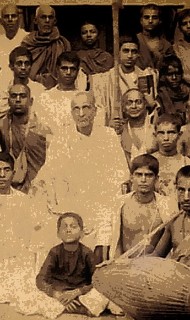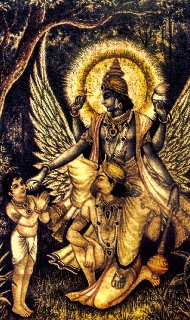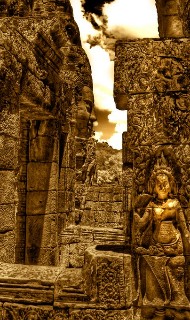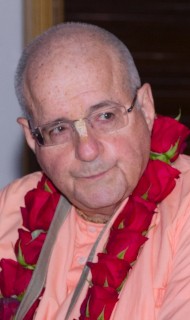
(Kadamba Kanana Swami, 17 August 2014, Goloka-dhama, Germany, Janmastami, Srimad Bhagavatam 10.41.6-10)
We remember the pastime of when Krsna first came to Mathura and he met a garland-maker, Sudama, who offered Krsna many nice garlands, sandalwood and other things. That garland-maker actually used go to Vrindavan regularly to collect flowers, so he had previously met Krsna and made offerings to Krsna with flowers, so that garland-maker was already recognized by Krsna as a devotee. At the end, he adorned Krsna and Balarama with beautiful garlands and they looked very beautiful. Then the two Lords offered to the surrendered Sudama, who was bowing before them, whatever benediction he desired. Sudama asked the Lord for unshakable devotion – devotion that could not be destroyed by anything. Then he asked the Lord for friendship with the Lord’s devotees and for transcendental compassion for all living beings. So this garland-maker was very intelligent. What would we ask for if we would suddenly, unexpectedly meet Krsna? What would we ask? It would not be so easy, ‘Well, Krsna, okay, give me love of God!’ But we can see the example of Sudama who was thinking much deeper about the matter than we are. Love of God is very good but Sudama asked to be given unshakable devotion, as he knew maya is very strong and did not want be affected by anything. Unshakable devotion means love of God!
This is very nice – this garland-maker who seems to be, in a way, a background personality; there is not a whole chapter in Srimad Bhagavatam dedicated to the garland-maker who offered some garlands to Krsna. But just see how profound his thinking is and how important unshakable devotion is, how important friendship with the devotees of the Lord are and how important transcendental compassion for all living beings is.
To approach Krsna we require blessings. Janmastami is an opportunity to approach Krsna and to really enter into Krsna’s reality. We are going to spend time remembering various pastimes of Krsna over the next few days and all these activities are actually taking us into Vrindavan because it is through remembering the activities of Krsna that we are getting entrance; as Jiva Gosvami explains, Vrindavan is a state of consciousness. So we are looking for blessings just as Sudama received benedictions from the Lord and asked for the unshakable devotion. Like this, we are gradually preparing ourselves so may we all be blessed by such a meditation of Sudama.
The fact is that by committing ourselves to Krsna, by focusing, by giving ourselves, by making offerings to Krsna – even if only for a day: chanting, cooking, hearing, intensely focusing on Krsna the entire day – then we will find that our relationship with Krsna has become so much nourished and strengthened that we realize that this Janmastami is not just a festival where we get enlivened by the association of devotees and a wonderful program until the next enlivening festival. No, we actually realize that if we really make a commitment to focus on Krsna, to really get serious, just for a day, then this Janmastami makes a permanent change in our spiritual life. We are permanently coming closer to Krsna, so in this way, each Janmastami is another step closer to Krsna.
Janmastami is particularly meant for us as it is an opportunity to connect in a very serious way with Krsna and in service to him, because then it will be a great source of strength that will benedict us in our spiritual life. We build on that and then we surrender again and in this way we build up our spiritual strength.
Scriptures recommend performing of naimitika kriya – exceptional devotion practice, or special spiritual activity during special occasions that brings new life and that we bring back to our everyday routine devotional practices of nitya kriya. So doing something special on this Janmastami can renew our everyday practice, bring new life and at the same time because we have for one day functioned on a higher level of surrender than usual, we have come one step closer to making that permanent and that has the lasting effect. With this meditation we can begin our Janmastami celebration and get ready to come before Krsna. We are anticipating with great eagerness Krsna’s appearance day and hope everyone will have a wonderful Janmastami. Janmastami that will make all the difference!
The article " Janmastami is coming " was published on KKSBlog.



 By Kripamoya Dasa
By Kripamoya Dasa By Yamuna Sundari devi dasi
By Yamuna Sundari devi dasi By Nikunja Vilasini Devi Dasi
By Nikunja Vilasini Devi Dasi





 By Radhanath Swami
By Radhanath Swami By Citraka dasa
By Citraka dasa By Kesava Krsna dasa
By Kesava Krsna dasa Dhruva Maharaja dasa: Lord Caitanya’s teachings to Rupa Gosvami at Prayag narrated in Caitanya-caritamrta Madhya-lila Chapter 19 are like a treasure map leading one to love for Radha-Krsna in Goloka Vrindavana. The path taught by Sri Caitanya Mahaprabhu begins with conditioned souls wandering in the material world (Texts 135-147) and reveals the course they should follow, symptoms detailing their progress, obstacles along the way, and finally the jewels of bliss in various forms (bhavas) derived from following this map. As an offering for Srila Prabhupada's Vyasa Puja this year I recorded Texts 135-257 with his purports as a 3 hour audiobook, and want to share it with devotees. Please visit http://sadhusangaonline.com and choose an option: listen online — download the files — or subscribe to the podcast.
Dhruva Maharaja dasa: Lord Caitanya’s teachings to Rupa Gosvami at Prayag narrated in Caitanya-caritamrta Madhya-lila Chapter 19 are like a treasure map leading one to love for Radha-Krsna in Goloka Vrindavana. The path taught by Sri Caitanya Mahaprabhu begins with conditioned souls wandering in the material world (Texts 135-147) and reveals the course they should follow, symptoms detailing their progress, obstacles along the way, and finally the jewels of bliss in various forms (bhavas) derived from following this map. As an offering for Srila Prabhupada's Vyasa Puja this year I recorded Texts 135-257 with his purports as a 3 hour audiobook, and want to share it with devotees. Please visit http://sadhusangaonline.com and choose an option: listen online — download the files — or subscribe to the podcast.



 By Sri Nandanandana dasa
By Sri Nandanandana dasa By Giriraj Swami
By Giriraj Swami By Parvati devi dasi
By Parvati devi dasi








